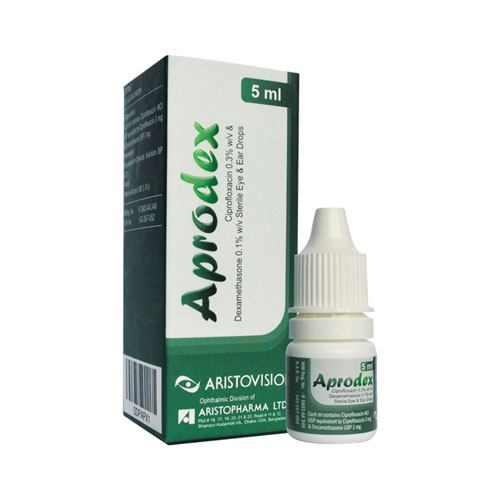
APRODEX Eye & Ear drops
Therapeutic Class
Antibiotic & Steroid
Indications
Eye: Aprodex is indicated for the treatment of steroid responsive inflammatory ocular conditions where bacterial infections or risk of bacterial infections co-exist. The use of a combination drug with an anti-infective component is indicated where the risk of infection is high or where is an expectation that potentially dangerous numbers of bacteria are present. The combination can also be used for post-operative inflammation and any other ocular inflammation associated with infection. Ear: Aprodex is also indicated in the treatment of ear infections accompanied by inflammation such as otitis exterma, acute and chronic otitis media etc. The combination may also be used post-operatively in the ear.
Chemical Composition
Ciprofloxacin USP 3 mg, Dexamethasone USP 1 mg
Packaging
Each plastic dropper bottle contains 5 ml eye drops.
Dosage & Administration
For Eye: 1 drop to be instilled into conjunctival sac(s) every four to six hours. During the initial 24 to 48 hours, the dosage may be increased to 1 drop every two hours. For Ear: Acute otitis media in pediatric patients with typanastomy tube: 4 drops instilled into the affected ear 2 times daily for 7 days. Acute otitis externa: 4 drops instilled into the affected ear 2 times daily for 7 days. Frequency should be decreased gradually or warranted in clinical signs. Care should be taken not to discontinue therapy prematurely.
Contraindications
Known hypersensitivity to any ingredient of the product. Herpes simplex and other viral conditions, mycosis, glaucoma, newborn babies, fungal diseases of ocular or auricular structures.
Side Effects
The most frequently reported drug-related adverse reactions seen with Ciprofloxacin are transient ocular burning or discomfort. Other reported reactions include stinging, redness, itching, conjunctivitis/keratitis, periocular/facial edema, foreign body sensation, photophobia, blurred vision, tearing, dryness, and eye pain. Rare reports of dizziness have been received. The reactions due to the steroid component are elevation of intraocular pressure (IOP) with possible development of glaucoma, and infrequent optic nerve damage, posterior sub capsular cataract formation, and delayed wound healing.

